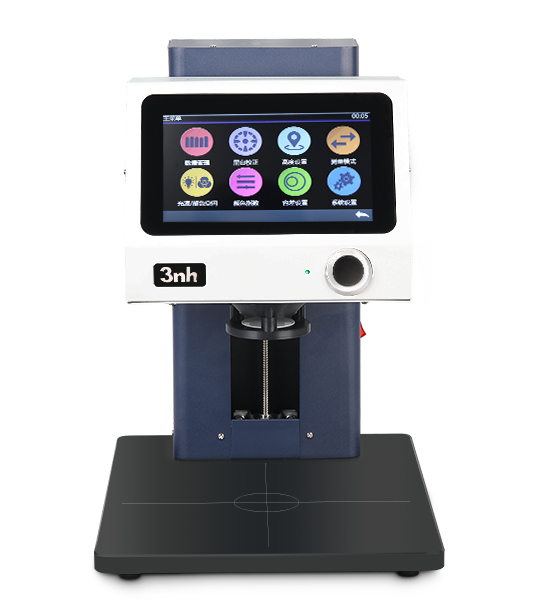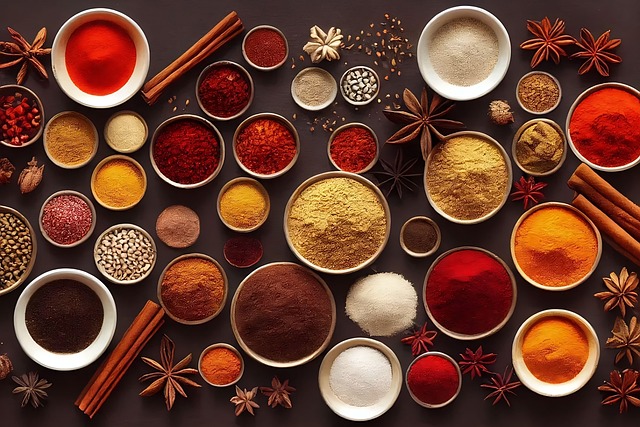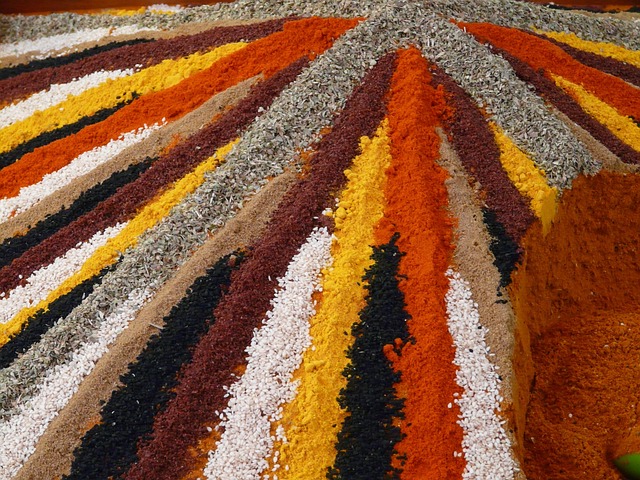1. What is a non-contact spectrophotometer?
A non-contact spectrophotometer is a device that measures the color of an object using spectral technology. This instrument uses a non-contact method, that is, it analyzes the color information of an object by emitting light of a specific wavelength and receiving reflected light. Unlike traditional contact measurement methods, non-contact measurement can avoid direct contact with the sample, thereby reducing damage or contamination to the sample, which has significant advantages, especially in the measurement of sensitive substances.

1.1 Working Principle of Non-Contact Spectrophotometer
The working principle of non-contact spectrophotometer is based on the reflection and spectroscopic analysis of light. The device emits a beam of white light to the surface of the sample. Different wavelengths will be reflected in different ways when they come into contact with different substances. The instrument receives the reflected light and splits it to measure the light intensity of each wavelength to obtain color information. These data are converted into specific color values through mathematical models. Common color spaces include CIE (International Commission on Illumination Chromaticity Diagram), such as CIE Lab value.
1.2 Characteristics and advantages of non-contact spectrophotometer
1. Non-contact : Avoids physical contact with the sample, reducing damage, contamination or changes to the sample's surface properties.
2. High Precision : Through precise analysis of spectral data, non-contact spectrophotometers are able to provide very accurate color measurements, especially suitable for complex color evaluation.
3. High efficiency : The measurement process does not require direct contact with the sample, which is suitable for rapid measurement of a large number of samples without the need to prepare too much sample surface.
4. Strong adaptability : Able to measure spice samples of different shapes, sizes or surface textures, widely used in various industries.
2. Color characteristics of spice samples
Spices often have complex color characteristics that are affected by their chemical composition, processing methods, storage conditions, etc. By accurately measuring the color of spices, their quality can be controlled to ensure product consistency and meet customer needs.

2.1 Visual characteristics and color differences of spices
The color of spices is determined by their natural ingredients (such as pigments in the petals, fruits or roots of plants). Different spices have significant differences in color, for example, vanilla is light yellow, while paprika is often red or orange. These color differences are usually closely related to the type of spice, the processing method and the storage state.
2.2 Relationship between color difference and ingredients of spices
The color difference of spices not only comes from their pigment content, but also is related to factors such as volatile substances in the spices, oil content, temperature changes during the drying process, etc. For example, some spices may undergo chemical reactions during high-temperature drying, resulting in color changes. Therefore, the color difference of spices can not only reflect their appearance, but also indirectly indicate their freshness and quality.
3. Why use a non-contact spectrophotometer to measure the color of spice samples?
3.1 The Importance of Accurately Measuring Spice Color
For the fragrance industry, color not only affects the appearance of the final product, but also directly affects consumers' purchasing decisions. Color consistency is crucial to the brand image, especially during the batch production and processing of products. Non-contact spectrophotometers can provide high-precision color measurement to help manufacturers ensure that the color of each batch of fragrance products meets standards and expectations.
3.2 Advantages of non-contact measurement: reducing sample damage
Traditional color measurement methods usually require contact with the sample surface to obtain color data, which may cause damage to the sample surface, especially for fragile spices or powders. Non-contact spectrophotometers obtain data through the reflection of light, avoiding such physical contact, and are suitable for spices samples with high requirements for surface integrity.
4. Working principle of non-contact spectrophotometer
Non-contact spectrophotometers rely on the principle of spectroscopy to measure the color of an object by analyzing the reflection of light at different wavelengths. This process generally includes the following steps:
4.1 Basic Principles of Spectrophotometric Colorimetry
Spectroscopic technology is based on the wave nature of light, and uses light of different wavelengths to excite the surface of an object. The sample surface will reflect or absorb light of different wavelengths to different degrees. The instrument uses a spectral detector to receive these reflected lights and calculate the color of the object through a mathematical model.
4.2 Relationship between light source, detector and spectral data
In non-contact spectrophotometers, the light source is usually a white light source or a light source of a specific wavelength. After the light source is irradiated onto the surface of the spice sample, part of the light is reflected back. The detector in the instrument receives the reflected light and converts it into an electronic signal, which is finally used to generate color data through computer software and displayed as a standard color space value (such as Lab value).
5. Color measurement steps of spice samples
Color measurement of spice samples usually includes three main steps: preparation, operation process and data analysis.
5.1 Preparation and sample handling
Before measurement, the sample surface needs to be properly treated, such as removing surface impurities and ensuring that the sample is uniform to avoid external factors affecting the measurement results. For example, for powdered spices, you can gently flatten them to ensure a smooth surface during measurement.
5.2 Operation requirements during measurement
When measuring, the non-contact spectrophotometer needs to maintain an appropriate distance from the sample to avoid environmental interference and ensure that the light source is evenly irradiated on the sample surface. In addition, interference from strong light or reflected light must be avoided to ensure measurement accuracy.
5.3 Data Analysis and Interpretation of Results
The measured data is analyzed by the instrument's built-in software, and standard color data, usually CIE Lab values, are output. These values can be compared with standard color values to evaluate the color difference and quality stability of the sample.
6. Application scenarios of non-contact spectrophotometer
Non-contact spectrophotometers are widely used in flavor production, research and development, quality control and other fields.
6.1 Quality Control in the Fragrance Industry
By regularly measuring the color of spice samples, manufacturers can monitor product consistency and ensure that each batch meets quality standards. Color changes may indicate differences in raw materials, processing methods or storage conditions, which is important for production control.
6.2 Consistency testing of spice products
The color consistency of spice products is an important indicator of their quality. Non-contact spectrophotometers can help companies conduct strict quality inspections to ensure that there is no color deviation in each batch of products, thereby ensuring the stability of consumer experience.
6.3 Flavor R&D and Formula Adjustment
In the process of developing spices, color measurement data can be used to help researchers adjust ingredient ratios or processing techniques based on the color performance of different spice formulas to optimize the final effect of the spice.
7. Calibration and maintenance of non-contact spectrophotometer
7.1 Importance of Regular Calibration
The accuracy of non-contact spectrophotometers depends on the precision of their spectral data. Therefore, it is necessary to calibrate the equipment regularly to ensure the reliability and consistency of its measurement results.
7.2 Equipment maintenance and care recommendations
To ensure measurement accuracy, it is recommended to perform regular maintenance on the equipment, including cleaning the optical lens, checking the status of the detector and light source, and ensuring the stability of the instrument.
8. Challenges and solutions of color measurement technology for spices
While non-contact spectrophotometers offer many advantages in the color measurement of flavor samples, they also present some challenges. Addressing these challenges is critical to improving measurement accuracy and operational efficiency.

8.1 Flavor surface heterogeneity and measurement error
The surface of spices may show inhomogeneities due to their natural characteristics or processing methods, such as differences in particle size and surface roughness. These inhomogeneities will lead to inconsistent light reflection, which will affect the accuracy of measurement. This problem is more obvious in powdered spices or samples with low pigment content.
Solution :
· For spices with uneven particles, use tools such as a vibrating platform to ensure that the sample surface is uniform and flat.
· When measuring, make sure that the instrument's illumination range covers the entire surface of the sample as much as possible to obtain more consistent light reflectance data.
· Reduce errors by taking multiple measurements at different locations and taking the average.
8.2 Impact of Environmental Factors on Measurement
Non-contact spectrophotometers are highly sensitive to environmental factors. For example, temperature, humidity, and lighting conditions may affect the reflection characteristics of light, resulting in deviations in measurement results. This is especially true for complex organic substances such as spices, which may change color due to environmental changes.
Solution :
· When measuring, try to keep the experimental environment stable, such as controlling the temperature and humidity, and avoiding direct sunlight or strong light interference.
· Use measurement equipment with environmental compensation functions, which can automatically adjust the measurement data to reduce interference from environmental factors.
· Regularly check the coordination between the instrument and the ambient light source to ensure their consistency.
9. Non-contact spectrophotometer market trends and developments
With the continuous advancement of technology, non-contact spectrophotometers are being used more and more widely in the fragrance industry, and are also facing more opportunities for innovation and development.
9.1 Technological Progress and Equipment Innovation
With the continuous development of optical technology, sensor technology and computer algorithms, the accuracy and performance of non-contact spectrophotometers have gradually improved. For example, the latest spectrophotometers can measure a wider spectral range and use more accurate spectral detectors to more accurately capture the subtle color differences on the surface of spices.
In addition, the intelligence of equipment is also improving. Nowadays, many instruments are equipped with automatic calibration, automatic data processing and remote operation functions, making the use of equipment easier and more efficient.
9.2 Future Prospects of Non-Contact Colorimeter in the Fragrance Industry
As the global requirements for food and flavor quality control become increasingly stringent, the market demand for non-contact spectrophotometers will continue to grow. Especially in the production, packaging and quality inspection of flavor products, color standardization and consistency will become an important indicator to ensure product quality. In the future, non-contact spectrophotometers will play an increasingly important role in the production lines, R&D laboratories and quality control departments of the flavor industry.
It is expected that with the global development of the spice market, international brands and multinational companies will have increasingly higher quality requirements for spices, which provides a broad market space for the promotion and application of non-contact spectrophotometers.
10. Conclusion and Future Outlook
The application of non-contact spectrophotometers in the fragrance industry provides a more accurate and efficient solution for color measurement. Through advanced spectral technology, non-contact spectrophotometers can quickly obtain color data of spices without contacting the sample, providing strong technical support for the quality control, research and development, and consistency testing of fragrance products.
Despite challenges such as surface unevenness and environmental factors, these problems can be effectively solved through reasonable operating specifications and technical means. With the continuous advancement of technology, non-contact spectrophotometers will be more widely used in the fragrance industry and make greater contributions to improving the quality standardization and precision of fragrance products.
Frequently Asked Questions (FAQ)
1. How does a non-contact spectrophotometer ensure measurement accuracy?
Non-contact spectrophotometers analyze the spectral data of reflected light and combine it with a high-precision spectral detector to obtain accurate color data without contacting the sample. The built-in calibration function of the instrument helps ensure the consistency and stability of the measurement results.
2. Are special environmental conditions required when measuring spices?
Yes, it is best to keep the temperature and humidity stable when measuring spices, and avoid direct sunlight and strong light interference. Try to measure in a controlled environment to reduce the influence of external factors on the results.
3. What flavor samples are suitable for non-contact spectrophotometers?
Non-contact spectrophotometer is suitable for all kinds of flavor samples, including powdered, granular or liquid flavors. It is especially suitable for flavors that are difficult to touch, fragile or need to protect the surface quality.
4. How do differences in spice color affect their quality?
Differences in the color of spices can mean differences in their ingredients, processing methods, or storage conditions. Color consistency is critical to brand image and consumer purchasing decisions, and changes in color can signal changes in the quality or freshness of the spice.
5. How can I improve the accuracy of spice measurements?
The accuracy of spice color measurements can be significantly improved by ensuring that the sample surface is uniform, the equipment is calibrated regularly, and the operating environment is controlled. At the same time, taking multiple point measurements and averaging them can help reduce errors.
6. Can non-contact spectrophotometers be used in other industries?
Yes, non-contact spectrophotometers are widely used in many industries, such as food, cosmetics, coatings, textiles, etc., especially in situations where high-precision color analysis and consistency testing are required, and they have irreplaceable advantages.








 0086 18165740359
0086 18165740359 Skype Online
Skype Online